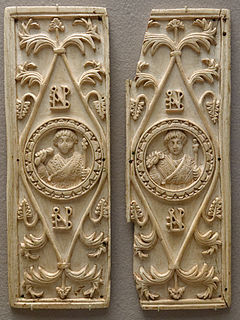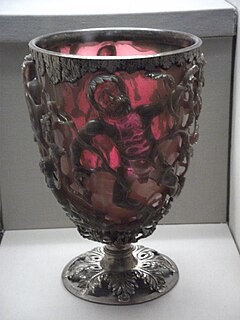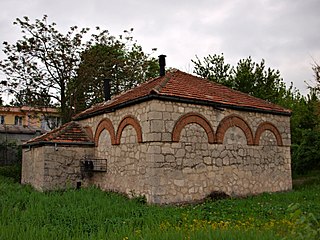 W
WByzantine art comprises the body of Christian Greek artistic products of the Eastern Roman (Byzantine) Empire, as well as the nations and states that inherited culturally from the empire. Though the empire itself emerged from the decline of Rome and lasted until the Fall of Constantinople in 1453, the start date of the Byzantine period is rather clearer in art history than in political history, if still imprecise. Many Eastern Orthodox states in Eastern Europe, as well as to some degree the Islamic states of the eastern Mediterranean, preserved many aspects of the empire's culture and art for centuries afterward.
 W
WThe Chronograph of 354, also known as the Calendar of 354, is a compilation of chronological and calendrical texts produced in 354 AD for a wealthy Roman Christian named Valentinus by the calligrapher and illustrator Furius Dionysius Filocalus. The original illustrated manuscript is lost, but several copies have survived. It is the earliest dated codex to have full page illustrations. The term Calendar of Filocalus is sometimes used to describe the whole collection, and sometimes just the sixth part, which is the Calendar itself. Other versions of the names are occasionally used. The text and illustrations are available online.
 W
WIn Late Antiquity, a consular diptych was a type of diptych intended as a de-luxe commemorative object. The diptychs were generally in ivory, wood or metal and decorated with rich relief sculpture. A consular diptych was commissioned by a consul ordinarius to mark his entry to that post, and was distributed as a commemorative reward to those who had supported his candidature or might support him in future.
 W
WDiocletian windows, also called thermal windows, are large semicircular windows characteristic of the enormous public baths (thermae) of Ancient Rome. They have been revived on a limited basis by some classical revivalist architects in more modern times.
 W
WThe Esquiline Treasure is an ancient Roman silver treasure that was found in 1793 on the Esquiline Hill in Rome. The hoard is considered an important example of late antique silver work from the 4th century AD, probably about 380 for the major pieces. Since 1866, 57 objects, representing the great majority of the treasure, have been in the British Museum.
 W
WThe Gladiator Mosaic is a famous mosaic of gladiators measuring about 28 meters, dated to the first half of the 4th century. It was discovered in 1834 on the Borghese estate at Torrenova, on the Via Casilina outside Rome. The antiquities which reinvigorated the Borghese Collection after it had shrunk following the sale of much of the collection to Napoleon I.
 W
WIn Late Antiquity, an imperial diptych is a theoretical type of ivory diptych, made up of two leaves of five panels each and each with a central panel representing the emperor or empress. They are so-named in contrast to consular diptychs. They were produced as unique examples, whereas each consular diptych was produced in large numbers to offer to the emperor on certain occasions, principally a nobleman's entry to the consulship.
 W
WThe Lycurgus Cup is a 4th-century Roman glass cage cup made of a dichroic glass, which shows a different colour depending on whether or not light is passing through it: red when lit from behind and green when lit from in front. It is the only complete Roman glass object made from this type of glass, and the one exhibiting the most impressive change in colour; it has been described as "the most spectacular glass of the period, fittingly decorated, which we know to have existed".
 W
WThe Missorium of Theodosius I is a large ceremonial silver dish preserved in the Real Academia de la Historia, in Madrid, Spain. It was probably made in Constantinople for the tenth anniversary (decennalia) in 388 of the reign of the Emperor Theodosius I, the last Emperor to rule both the Eastern and Western Empires. It is one of the best surviving examples of Late Antique Imperial imagery and one of the finest examples of late Roman goldsmith work. It is the largest and most elaborate, and the most famous, of the 19 surviving vessels believed to represent largitio ("largesse") or a "ceremonial gift given by the emperor to a civil or military official".
 W
WPersian-Sassanide art patterns have similarities with the art of the Bulgars, Khazars, and Saka-Scythians, and have recurred in Asia. They predominantly feature motifs of fighting animals. Gold was frequently used as a base for their art creations.
 W
WThe Poet and Muse diptych is a Late Antique ivory diptych that appears to commemorate, and to flatter, the literary pursuits of the aristocrat who commissioned it, so that it stands somewhat apart from the consular diptychs that were carved for distribution to friends and patrons when a man assumed the consular dignity during the later Roman Empire. The original inscription in this example, unusually, will have been carried out on the borders of the reverse side, which was infilled with a layer of wax for writing on, the ivory diptych being a very grand example of a wax tablet; the inscription has not survived, so there can be no way to identify the writer for whom it was made. In the literature that has accumulated about this diptych, various prominent figures have been offered as candidates: Ausonius, Boethius, and Claudian, and even earlier figures, like Ennius and Seneca, with whom the donor wished to be associated
 W
WThe Quedlinburg Itala fragment is a fragment of six folios from a large 5th-century illuminated manuscript of an Old Latin Itala translation of parts of 1 Samuel of the Old Testament. It was probably produced in Rome in the 420s or 430s. It is the oldest surviving illustrated biblical manuscript and has been in the Berlin State Library since 1875-76. The pages are approximately 305 x 205 mm large.
 W
WThe Queriniano diptych, called Dittico Queriniano in Italian, is a Late Antique ivory diptych that was likely made to celebrate a wedding.
 W
WThe Roman Tomb of Silistra is an Ancient Roman burial tomb in the town of Silistra in northeastern Bulgaria. Dating to the mid-4th century AD, the Roman Tomb is the best-preserved architectural monument of the Ancient Roman city of Durostorum. The tomb is considered "one of the most investigated and most discussed monuments of the late antique art in Bulgaria" and the Balkans, owing in large part to the quality and extent of its interior frescoes.
 W
WThe Seuso Treasure or Sevso Treasure, is a hoard of silver objects from the late Roman Empire. The first pieces appeared on the market in London in 1980, and the treasure was acquired by a consortium headed by Spencer Compton, 7th Marquess of Northampton. Documentation was provided in which it was stated that it had been found in the Tyre and Sidon regions of Lebanon. It was put up for sale in New York City in 1990 by Sotheby's, but was halted when the documentation was found to be false, and the governments of Hungary, Yugoslavia and Lebanon made claims of ownership. The claims of ownership by these countries were rejected by a US court, and the treasure remained in the possession of the Marquess of Northampton. Scotland Yard still has an open case on the matter.
 W
WSpolia is repurposed building stone for new construction or decorative sculpture reused in new monuments. It is the result of an ancient and widespread practice whereby stone that has been quarried, cut, and used in a built structure is carried away to be used elsewhere. The practice is of particular interest to historians, archaeologists and architectural historians since the gravestones, monuments and architectural fragments of antiquity are frequently found embedded in structures built centuries or millennia later. Archaeologist Philip A. Barker gives the example of a late Roman period tombstone from Wroxeter that could be seen to have been cut down and undergone weathering while in use as part of an exterior wall, then, possibly as late as the 5th century, reinscribed for reuse as a tombstone.